Financial statements are representations or substitute attributes meant to measure attributes of a company.
Income Statement
Balance sheet is like a photograph taken on a particularly date. Meanwhile income statement depicts what occurred during the period that changed the company’s position from the beginning of the period to its position at the end of the period.
The income statement answers the measurement question: how did the company perform? Because it shows how the company’s activities in the period impact its assets and liabilities.
Revenue
Revenue is an increase in assets or decrease in liabilities, brought about by activities that are center to the normal operations. A transaction that represents revenue for one company, may not represent revenue for another company. The net income being driven by revenue suggests that the net income performance will be persist in the future.
Cost of goods sold
Goods are assets either manufactured or purchased with the intent to be sold to customers. Total cost of goods available for sale presents the cost of inventory at the beginning of period. During the period, more goods are added to inventory. At the end of the period, the total cost of goods available for sale is divided into 2 buckets:
- Cost of goods sold (on income statement)
- Cost of inventory (on balance sheet)
Cost flow assumption need not match the physical flow of good. But the choice can affect the Cost of goods sold on income statement. Cost flow assumption has three types:
- First in first out (FIFO)
- Last in first out (LIFO)
- Average cost
Gross profit
Gross profit is an important indicator of company’s performance and future prospects. Large gross profit might suggest that the company is less at risk to small change in the price of manufacturing or purchasing of inventory.
Gross profit = Revenue - Cost of goods soldExpenses
Expenses represent outlays of resources as part of the normal operating activities. Expenses are associated with operating transactions that either decrease company’s assets or increase liabilities. There is tremendous variation in what expenses company incur, depending on company size, industry, its strategy and structure.
Depreciation expense allows a company to spread the cost of an asset, over the periods it expects benefits from the asset. Extraordinary gains and losses are those that arise from events that are both unusual and infrequent.
Net Income
Line items like gains, losses, expenses are either added to or subtracted from gross profit. The sum of these adjustment to gross profit, yields net income, which is often served as a summary measure for company’s performance.
Statement of comprehensive income
The statement of comprehensive income can be found either as an extension to the income statement or shown separately, showing two items:
- net income
- other comprehensive income
- companies who hold investments in other companies.
- companies that offer pensions to employees
- companies have significant operations outside of their home country
Statement of Cash Flows
The cash flow statement does not depict the change in the entire balance sheet, but present how one balance sheet item, the cash account, changed during a period. Cash flow refers to cash leaving the company or arriving into the company as the result of transactions or events. The cash flow statement tells us the story of how the company’s cash position changed from the beginning of the period to the end of the period. The cash flow statement is separate into 3 sections, with each section specifying a particular source or use of cash:
- Cash flows from operating activities
- Cash flows from investing activities
- Cash flows from financing activities
Operating activities
This section has a unique representation called “the indirect approach to presenting cash flows”. It is a sort of reconciliation of net income to cash flows from operative activities. The company begins with net income, and make adjustment to net income to yield cash flows from operating activities. Some of adjustments are:
- Transactions or events that impact net income but not cash, e.g.: depreciation expense.
- Transactions or events that impact net income and cash, but are not operating activities.
- Timing differences between an operating transaction’s effect on net income, and its effect on cash.
Investing activities
Cash flows from investing activities relate to the impact of transactions associated with the company’s long term assets.
| Inflows | sold land, equipment, or stock of another company and receive cash in return |
| Outflows | pay cash for land, equipment, or stock of another company |
Financing activities
Cash flows from financing activities relate to the impact of transactions associated with the company’s long term liabilities or its equity.
| Inflows | selling its own stock for cash or receiving a cash loan from a lender |
| Outflows | use cash to payoff a loan |
Notes of Financial Statements
These notes accompany the financial statements and usually appear after the Statement of Cash Flows.
- Summary of significant accounting policies
- Subsequent events
- Contingency losses
- Many many more
Consistency of financial statements is really important. The volume of notes has been significantly increased in past few decades. One reason is there has been a significant increase in accounting standards and business transactions. In most cases, they require more disclosures. The second reason is that management has discovered disclosure as a means to help manage their own risk.
Auditor’s Report
Auditor’s value depends wholly on the auditor’s credibility. Without high integrity or ethics, the auditor’s value is completely diminished. Auditor’s report is a formal opinion by an independent auditor, regarding a reporting entity’s financial statements. Readers of the report can learn whether the financial statements are fair representation, or materially misstated, or in some cases, the auditor is not able to render an opinion.
In general, auditor’s report includes a number of different topic or elements. It will briefly describe auditor’s responsibility, management’s responsibility, auditor’s opinions, and signature. An auditor’s report without issues does not mean the company is safe to invest. An audit does not always provide all the financial and non-financial information. But an investor should be able to take greater comfort and have more confidence.
However not all companies are required to have an auditor’s report accompanies their financial statements. But a bank may ask the financial statements be audited, when the company is seeking a loan from the bank.
Ratios
Trying to make comparisons across companies of different sizes raises problems. The solution is ratios, which are most useful when comparing the budgets, competitors, or prior periods. There are a few ratios are helpful:
- How much net income was generated for each dollar of assets the company held during the year.
- Earnings per share (EPS): Net income divided by average shares of common stock outstanding.
- Risk ratio as current ratio, which is company’s current assets divided by its current liabilities.
My Certificate
For more on Financial Statement: Company Performance, please refer to the wonderful course here https://www.coursera.org/learn/income-statement
Related Quick Recap
I am Kesler Zhu, thank you for visiting my website. Checkout more course reviews at https://KZHU.ai



